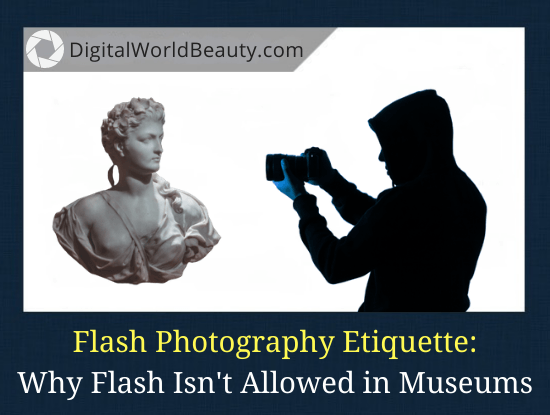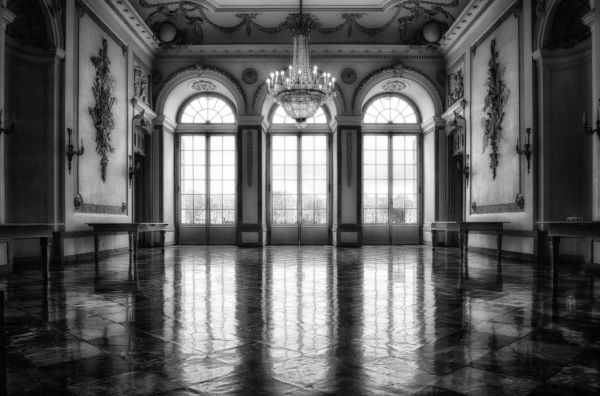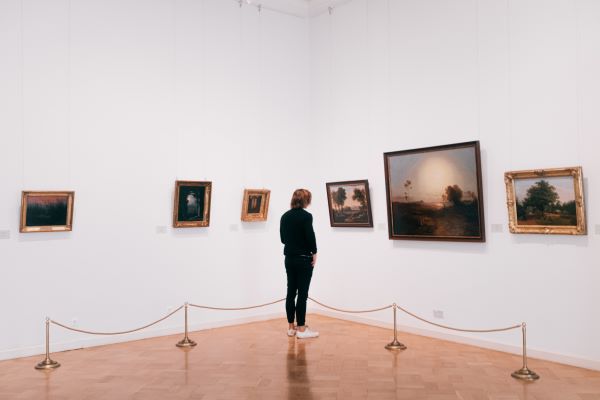Please note: As an Amazon Associate I earn from qualifying purchases. I also work with other affiliate partners and may be compensated from the links below. Details here.
Why Is Flash Photography Not Allowed in Museums and Art Galleries? (Guide)

Does flash photography damage artwork? The reason behind ‘no photography’ policy.
Museums and art galleries are places filled with history, culture, and artistry. At the mere mention of these locations, you can’t help but imagine what beautiful things are stored inside.
These places have become more open to the public, encouraging people to visit. As a photographer, it’s natural to have that urge to click the shutter and share the wonderful scene with the rest of the world. The question is: are you allowed to do this?
Flash photography is not allowed in museums for a variety of reasons. It could be distracting to other visitors, could possibly compromise the place’s safety, or worst, it could potentially damage the artwork inside. With that said, just spare yourself the hassle and keep your camera lights off.
If you are planning to visit one of these places someday, read on to learn:
- the reasons why using flash is not allowed in art galleries
- proper museum photography etiquette
- what to do when seeing ‘no photography’ sign
…and many other things to keep in mind when going to these cultural centers.
Shall we start?
What Is Flash Photography?
In the world of photography, there are two different types of light that are commonly used: natural light and artificial.
Natural light comes from sources like the sun or a lamp while artificial light (like from a strobe) can come from anything that emits an electric charge.
Examples of these are the camera’s built-in flash bulb or any number of other devices designed specifically for taking photos with artificial lighting including strobes, beams, and more.
A lot of people think that using only natural lighting will give them the best results but in many cases using artificial light can also have its advantages.
You won’t always be photographing subjects under the bright sun. Sometimes, you will need to explore venues with low lighting conditions and it can be very difficult to do the job without the aid of strobes.
Beams vs. Natural Light: Which is Better?

As a photographer, you will encounter so many instances where you have to choose between using flash or just rely on natural lighting. Have you ever wondered which is the better option?
Well, both actually have their own set of advantages, and setbacks (as usual).
The abundance of natural light is one of the best things about it. You don’t need to invest in expensive lighting equipment because you can actually get it for free – during the daytime!
On top of that, the sun’s rays cast a different glow or luminance on your subject, making it feel more realistic and “natural”. The only downside is that this isn’t available all day long. Though most places have longer days than nights, the sun will still set and the skies will turn dark.
If you only rely on the sun as your source of lighting for photography, then you won’t be able to do more during nighttime or in places with low lighting conditions. That’s the biggest drawback you need to keep in mind for this.
On the other hand, a camera flash can be very convenient when you shoot indoors, especially in poorly lit places. It can also come in handy when you go out at night and shoot really dark scenes (though it might not have a really nice effect on the photos).
Strobes can also be very useful in studios, especially when doing portraiture. It gives you control over how to properly illuminate your subject regardless of the positioning.
But the major drawback with artificial light for photography is that they are rather expensive. Plus, most strobes are not very portable, so you’ll have to carry around bulkier and heavier stuff when doing outdoor shoots.
So, what is really the best type of photography light when visiting museums and galleries, you may ask.
Short answer: natural light!
The thing is…
Most of these places have a “no flash photography sign” at every entrance and corner. So if you don’t want to get kicked out of the venue, it will be safest to follow their rules. You will have to rely on either natural light or the museum’s lighting fixtures.
Why Don’t Museums Allow Photography
I know you’ve heard so many stories where people are banned from bringing phones or cameras inside a building, much so in art galleries and museums. But, do you know why these restrictions exist? If not, then this post will open your mind to the various reasons why these rules are imposed.
-
Copyright issues
Sculptures, paintings, and other forms of artworks, especially those displayed in exhibits, have official copyrights. One of the main reasons why they don’t allow you to take photos of these masterpieces directly is because the copyright might be violated.
Legally, the artist or the owner of the piece has full rights over it. The tendency with allowing people to take pictures of them is that some might reproduce a print/copy of the artwork and present them as their own, intentionally.
When this happens, there is a breach of copyright and the perpetrator will face legal consequences. If you are in the artist’s shoes, would you be happy seeing your work altered or claimed by another person? Certainly not!
-
Security issues
Most of the things inside museums are of high monetary value, and this is one of the reasons why the security outside and inside these places are tight.
Now, if people are allowed to snap images anywhere inside, the entire place’s security might be compromised. It will be easier for thieves to access the exits and entrances because of these photos. A lot of people might also get familiar with the interior layout, which is like an invitation to ill-intentioned visitors.
-
Potential damage to artworks
This is one of the most important and emphasized reasons why you are not allowed to take photos of artworks inside galleries. A lot of things have been said about this strict rule, but not many of you are aware as to why curators strongly discourage this.
But really, can flash photography damage paintings?
Well, the truth is, it could. Many paintings, especially those from ages ago, are very sensitive to light. Discoloration is often associated with overexposure to various heat and lighting elements.
That’s is how flash photography can potentially damage art, especially paintings.
But, many studies have been conducted about this and only a few have proven that a quick camera light/beam can do so much damage to a piece of art on the wall.
The only thing that’s making this point very strong is when you think about the effect of the collective action – several people taking several shots with flash.
The effect might be minimal if only one person does it, but when everyone follows, that’s another story and this is where damage begins.
-
Disturbs other people’s experience
This might not be a scientific explanation on why you can’t snap photos inside galleries as much as you like, but it’s the most understandable reason.
Cameras, even those with silent shutter mode, can still produce clicking sounds that might disturb other people inside. Plus, when you use flash, this could catch the attention of museum-goers as well, keeping them from appreciating the artwork before their eyes.
Art Gallery Photography Etiquette

So, can you really take photos in museums? Isn’t there a “no photography allowed policy” in art galleries?
These questions always come to mind, almost automatically, whenever you plan on visiting these places. Well, obviously, this has been a common topic for debate between photographers, artists, and curators altogether.
If you are planning to visit an art exhibit soon, then here are the things you need to keep in mind:
-
Know the rules
This is imperative. Before going to the location, it is very important to check the various rules and restrictions imposed by the curator. This will help you have a smoother visit.
The thing about knowing the rules beforehand is that you get to set your limitations. You will know exactly what to do and what not to do during your visit. Because if you don’t follow the rules, chances are you’ll be called out or worse, kicked out from the venue.
-
Respect other people’s space/experience
It is also important to keep in mind that you don’t exclusively own the museum. It is still a public space if you think about it.
You are not the only person visiting unless you requested to have an exclusive or private viewing. So chances are, there will be many people around – each one of them intends to appreciate the masterpieces inside.
If you want to take a photo of a specific work, then be careful not to invade other people’s space. If there is someone ahead of you, wait for your turn so you can take a decent shot without offending someone else.
-
Be as discreet as you can
This is in connection to respecting other visitors’ experiences. As much as possible, be discreet in taking photos.
If you are using a smartphone, please make sure you turned off your shutter sound to avoid unnecessary noise. If you are using a compact, mirrorless, or DSLR, minimize snapping too many shots for one artwork.
Since it will be harder to silence the shutter of these gears, you will have to limit your shots to make less noise.
But this doesn’t only apply to camera shutters. You should also be discreet when speaking and moving around because most people are there to solemnly appreciate the masterpieces.
-
Make way for other viewers
It is quite rude to stand in front of an artwork for a long time, especially if you know that there are people lining up behind you to look at it as well.
As photographers, it is understandable that you want to properly compose your images, but you should also be mindful of the other people waiting in line. You get a few snaps and move along to make way for others.
-
You don’t need photos of every artwork
If it’s your first time going to an art exhibit or museum, it’s normal to feel overwhelmed by the numerous works of art. However, you should also remember that you don’t need to take photos of everything!
In order to save your time, energy, and storage space (of course!), just choose the most outstanding pieces or the ones that resonate with you so well.
After all, you’re just there to visit, not open an art gallery of your own, right?
-
Don’t get too close
Most of the artworks inside galleries are very delicate, not to mention very expensive! It would be best to keep a good distance when taking photos. You don’t want to end up accidentally touching and breaking a 200-year-old statue, do you?
Though curators normally put cordons in front or around the masterpiece, some people can get really excited and might want to get too close to satisfy their curiosity.
If your photography equipment has excellent zoom capabilities, then I highly suggest taking advantage of it rather than physically going near the object. It’s safer that way!
-
No FLASH!
Of course, we should never forget about this rule. No FLASH allowed. Most, if not all, museums have this policy. By now, I think you already know and understand why you should follow this rule.
Aside from potentially damaging paintings, it could also disturb other visitors as well. So might as well keep taking photos lowkey.
Taking Great Photos in Museums without Flash
You might be wondering: if it’s banned to take photos inside art galleries, why do I see a lot of influencers posting things like this?
Truth is…
There are areas inside and outside the museums where you are allowed to take photos. However, you should keep in mind the “no flash” rule.
If you are afraid of not getting decent shots because of this restriction, find out some easy techniques on how to get that “gram” worthy shots without breaking the rules!
-
Know your goal beforehand
Setting your goals before going to the location lets you have a headstart. If you’ve already done your research about the gallery and you clearly know what you need to take photos of, you will less likely get distracted by other artworks you can see during the visit.
This will save you lots of time and energy as well. But of course, if there’s something that perks up your interest, it’s never bad to have a look and take some snaps.
-
Adjust ISO levels
Knowing how to set your camera to the proper ISO levels is an advantage. When capturing scenes under low light conditions, this setting will greatly impact the resulting images.
If your ISO levels are high, you can allow more light to come into the frame. However, you cannot just set this at the max level. There is always a trade-off between photo quality and brightness.
As this setting’s level increases, it could also mean more digital noise that won’t look too good on screen, much so in print. So, before you go taking pictures, experiment on different ISO settings at home on different lighting conditions so you can be more prepared for the visit.
-
Pay attention to shutter speed and aperture
Remember, it’s not only ISO that plays a part in making your images look as bright as they can be. There’s also shutter speed and aperture.
Generally speaking, the slower the shutter speed, the more light can reach the imaging sensors. As for the aperture, the wider it is, the brighter the shots will be. But then again, don’t just go setting it at max because you might not get the results you are expecting.
You can practice and experiment with these settings at home as well. If you are not so sure how they work, then I suggest you check out the amazing discussion by Photography Life about the basics.
-
Play with available light
Since you won’t be able to use an external flash, you will have to make use of the available light inside the venue. This is the best chance to get really creative!
You can play with the place’s lighting and compose your shots so they create contrast and drama. You can also look for artworks near windows where you can make use of the gentle sun rays you can find.
Final Thoughts

It’s true that most art galleries and museums don’t allow flash photography. They have their reasons, and as a visitor, you will need to abide by their rules.
Actually, it’s not a crime to take photos inside these places. After all, the pieces of art inside are meant for public viewing. But despite that fact, you still need to know your limits as a photographer and check the rules thoroughly to avoid facing legal consequences.
Also, let’s not forget that the exterior layout of these places is usually as wonderful as the interior. In fact, many photographers pay more attention to the infrastructure and facade rather than what you can find inside. And most curators don’t impose restrictions outside, so you’ll be free to click your shutter as much as you want.
Now, I’d like to hear from YOU:
- Have you ever tried visiting art galleries and museums?
- Were you able to take pictures of your favorite artworks?
- Are there strict rules imposed when you had your visit?
Please let us know your thoughts in the comment section below!
The author should have done some more research on whether or not flash photography damages art, particularly paintings. That myth is pretty much debunked.
Just about every article on this subject parrots the myth mechanically WITHOUT researching the BASIS of such thoughts to seek whether or not the basis has a scientific argument!!
The link below describes the origin of this myth and how its so-called “scientific basis” has been shredded!
https://www.imaging-resource.com/news/2012/07/19/does-flash-photography-really-damage-art-the-persistence-of-a-myth
Hey Roy! Thanks for the input. That’s a really good resource you have right there. Thanks for sharing.
I totally understand where your sentiments are coming from. The damage to artworks was only mentioned as part of the several reasons discussed in this post, that’s why there was no discussion of an in-depth scientific basis behind it. But now that you have mentioned it, you gave me an idea to create a separate post focused on this potential (and scientifically proven) effects of the camera flash on artworks, especially paintings. Again, thank you!
Great post. While we all know that flash photography can disrupt the viewing experience for other museum-goers, many don’t realize the potential harm it can do to artwork.
It’s good to educate folks about that.
I may be old-fashioned, but I think it’s important to remember that art is meant to be experienced firsthand, and don’t tend to take out the camera to capture everything I see.
Thank you for sharing, appreciate you leaving a comment!